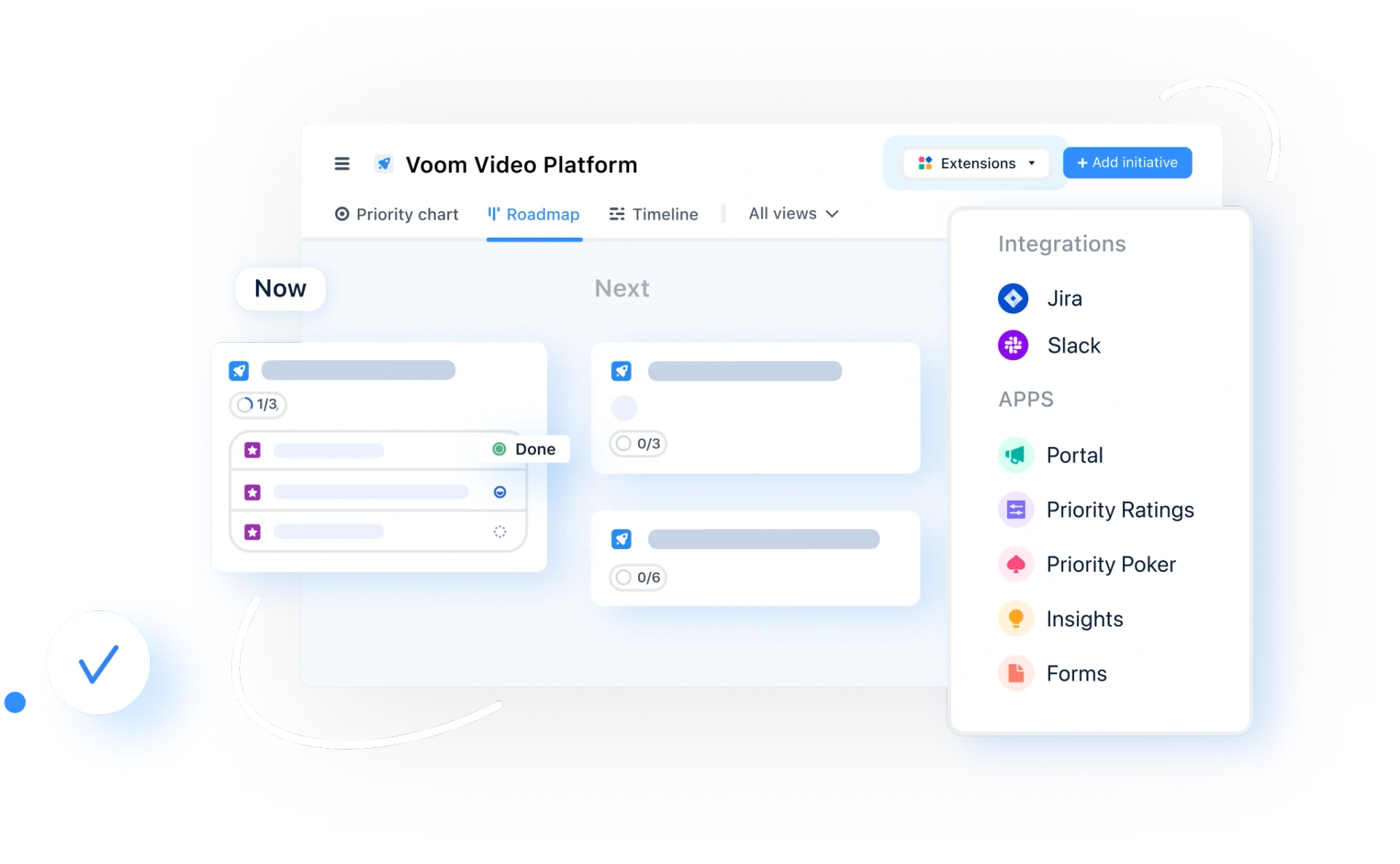6 challenges airfocus helps solve to build stakeholder relationships

Strong stakeholder relationships are at the heart of successful product leadership – but the skills required are rarely taught, and often a challenge. Competing priorities, scattered information, and fast-paced environments can quickly erode trust and slow progress.
By centralizing product strategy, giving stakeholders real-time visibility, and backing decisions with data, airfocus supports stakeholder management from a source of friction into a foundation for partnership.
Here, we discuss the ways in which airfocus supports stakeholder management.
Challenge #1: Time spent updating teams
With airfocus, product leaders can reduce tedious status meetings and directly address stakeholder questions with clear, up-to-the-minute dashboards and roadmaps. This ‘self-service’ model means that stakeholders can check timelines at any time, eliminating unnecessary back-and-forth.
For organizations operating at scale or across multiple geographies, this becomes indispensable. Cristina(Xina) Trocco, Director of Product Operations at Unanet, describes how airfocus brought fragmented teams together: “We’ve just spun up a couple of shared roadmaps using the links, and we shared it out during our QBR last week. That is now getting exposure across different departments... The feedback has been very positive. Everyone’s been excited just to see transparency and visibility across the different product lines that hasn’t happened before. I think they’ve already gotten rid of a spreadsheet and a meeting – that was a quick win.”
Challenge #2: From scramble to structure (visibility)
Before adopting airfocus, many organizations wrestle with scattered information, manual updates, and a lack of transparency that erodes trust.
Tyler Huish, Director of Product Management at Extra Space Storage, recalls: “Stakeholders struggled to understand prioritization decisions. Product managers spent hours manually updating information. Documentation quickly became outdated. Cross-product prioritization remained a constant challenge... the biggest problem was stakeholders. The only way they knew what was being worked on, and its progress and timing, was by asking the product manager directly. We were having the same conversation over and over again, making it hard to build trust.”
airfocus solves this by creating a single source of truth for product work – consolidating roadmaps, priorities, and feedback in one place. In Huish’s experience, this shift fundamentally changed the conversation.

This visibility theme resonates across teams. At Sano Genetics, airfocus’ shared roadmaps provided clarity and efficiency: “Everybody in the business has ‘view’ access to it... It’s been a huge time saver and a huge enabler for us, and for me specifically,” says Sarah Green Snider, SVP of Product & Delivery.
If you haven’t tried ‘slicing and dicing’ your roadmap, book a demo.
Challenge #3: Tailored communication
Even when stakeholders can see what’s on the product roadmap, they also need to understand why it’s on the roadmap. Without context, priorities may appear to shift arbitrarily, creating frustration or mistrust.
airfocus makes it simple to tailor communication for different audiences. With customizable views, product teams can “slice and dice roadmaps” in just a few clicks – from a detailed breakdown for internal teams to a high-level version for executives or company-wide updates. Unlike static decks in PowerPoint or Figma, these views remain automatically up-to-date, ensuring consistent information across the organization.
This transparency helps rebuild trust. Stakeholders can not only see progress but also the reasoning behind decisions. As Tyler Huish explains, airfocus reduces the need for “entire meetings explaining why one initiative was prioritized over another,” since stakeholders can view the evaluation criteria directly in the tool.
Challenge #4: Insight-driven decision-making
When product decisions are made on intuition rather than evidence, it often leads to misalignment and mistrust. Our State of Product Ops in 2025 report shows that only 17% of strategic decisions are informed by market or user feedback, while a majority are swayed by leadership intuition – and 92% of professionals say the “loudest voice in the room” carries too much weight. It’s a dynamic that frustrates both product teams and stakeholders.
airfocus addresses this challenge by replacing subjective, ad hoc prioritization with transparent, repeatable frameworks. By centralizing feedback from multiple channels, surfacing actionable insights, and logging the rationale behind every decision, it ensures that roadmaps are driven by customer needs and clear evaluation criteria – not politics or gut instinct.
Ken Thompson, VP of Product at Buildkite, notes that he brought in airfocus to “take the volume out of the room, get to some data-driven decisions, and data-driven insights.”
A popular feature is Priority Poker, which makes prioritization collaborative, transparent, and even enjoyable.
With tools like Priority Poker and built-in scoring systems, product leaders can democratize decision-making, invite broader voices into the process, and defend priorities with confidence – building trust with both their teams and stakeholders.
Challenge #5: Collaboration
Large, distributed organizations often struggle with fragmented communication and siloed teams, leading to duplicated efforts and a breakdown in project visibility.
Product management is a delicate dance between creative ideation and structured planning. With the combined power of Lucid and airfocus, product teams can move effortlessly between structured and unstructured work while promoting alignment among technical teams and greater transparency to leaders and executives.
For example, you can brainstorm new feature ideas based on user feedback. You can use Lucid to visually group pain points, sketch rough concepts, and collaboratively prioritize ideas by impact and effort. Once a clear direction emerges, you transfer the best ideas into airfocus, where they become structured backlog items for further refinement and prioritization.
Ricoh Europe, for example, had offices in over 150 countries and found themselves working in silos. Their teams had a "disconnect between design, product work and development," which resulted in significant issues with product delivery.
airfocus improves collaboration by providing a shared workspace where everyone can see the end-to-end product workflow. It offers features like Gantt chart views, which improve communication about project timeframes, and shared workspaces that provide cross-product oversight. This allows teams to visualize dependencies across different projects, making conversations about sequencing "much more productive".
With airfocus, Nathan Thomas, Head of Product for Ricoh Digital Experience (RDx) at Ricoh Europe, says, "Everyone's there together now.” The platform's ability to seamlessly integrate with existing tools like Jira also helps to streamline processes and save time on administrative work. This integration ensures that product managers can work at a high level in airfocus while the detailed work is managed in Jira, with everything staying automatically in sync.
Challenge #6: Managing priorities
Shifting priorities are a constant challenge for product teams, with 43% of respondents to our stakeholder management survey citing "constant delays" caused by them. This can lead to missed deadlines and frustrated stakeholders. airfocus helps manage this by allowing teams to connect their product plans back to company initiatives and OKRs. This clear alignment with strategic goals makes it easier to say "no" to tasks that aren't aligned with the overall vision.
Ken Thompson suggests that with shifting priorities, the focus should be on "fixed time, flexible scope". He advises teams to accept the changes but "report the impact". airfocus makes this possible by providing a platform where the impact of shifting priorities can be made visible and explicit. By setting a clear product vision and strategy that is documented and accessible, airfocus helps teams maintain focus and manage expectations effectively.
Want to see how airfocus by Lucid could work for your team’s specific workflow and challenges? Book a demo.
Emma-Lily Pendleton

Read also



Create effective product strategy

Experience the new way of doing product management




